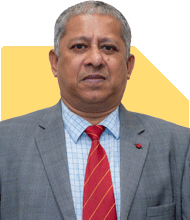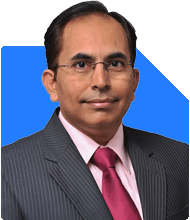Worried about retirement income?
Ramalingam Kalirajan |8098 Answers |Ask -Follow
Mutual Funds, Financial Planning Expert - Answered on Jan 20, 2025
He has an MBA in finance from the University of Madras and is a certified financial planner.
He is the director and chief financial planner at Holistic Investment, a Chennai-based firm that offers financial planning and wealth management advice.... more

I need to invest 1c so that i get monthly regular income upon my retirement, is there any safe investment other than bank fd or post office fd,
Key Considerations
Prioritise Safety with Growth
Your retirement income must sustain over decades, so capital preservation is critical.
Ensure Inflation-Adjusted Returns
Inflation can erode the purchasing power of your income. Choose options with inflation-beating potential.
Tax Efficiency is Crucial
Select investment options that minimise tax outflow on returns.
Diversified Investment Options for Monthly Income
Systematic Withdrawal Plans (SWPs)
SWPs from mutual funds offer flexibility in withdrawing monthly amounts.
Invest in balanced or debt-oriented mutual funds for stable returns.
Withdraw systematically while keeping the corpus growing.
SWPs provide tax-efficient income. Long-term capital gains (LTCG) above Rs. 1.25 lakh are taxed at 12.5%.
Short-term capital gains (STCG) are taxed at 20%.
Debt funds follow your income tax slab for LTCG and STCG.
SWPs are better than FDs due to potential capital appreciation and flexibility.
Debt-Oriented Mutual Funds
Debt funds invest in government securities, corporate bonds, and money market instruments.
They offer relatively stable returns with moderate risk.
These funds are suitable for consistent monthly withdrawals.
Debt funds also provide indexation benefits for long-term taxation.
Corporate Bonds and Debentures
High-rated corporate bonds offer safety with better returns than FDs.
Look for AAA-rated instruments for low credit risk.
Select bonds with regular interest payouts.
However, these require due diligence regarding issuer stability.
Senior Citizen Savings Scheme (SCSS)
SCSS is a government-backed scheme offering regular income.
This scheme has a five-year lock-in, extendable by three years.
Interest is paid quarterly, ensuring a steady cash flow.
SCSS is safe but capped at Rs. 30 lakh per individual.
RBI Floating Rate Bonds
These bonds provide semi-annual interest payouts.
Interest rates are linked to the RBI's repo rate.
They offer inflation-adjusted returns.
These bonds are suitable for retirees seeking secure income.
Balanced Advantage Funds
These funds dynamically allocate between equity and debt.
They reduce risk during volatile markets and capture growth during uptrends.
Suitable for retirees willing to take moderate risk.
Balanced advantage funds offer tax-efficient SWPs.
Sovereign Gold Bonds (SGBs)
SGBs offer interest income and capital appreciation.
Interest is paid semi-annually at 2.5% per annum.
Redemption gains are tax-free if held till maturity.
Allocate a small portion here for diversification.
Building a Strategy
Allocate Across Asset Classes
Divide your Rs. 1 crore across equity, debt, and hybrid funds.
Equity for long-term growth.
Debt for stability.
Hybrid funds for balance.
Keep a Contingency Fund
Maintain at least six months' expenses in a liquid fund.
Regularly Review Your Portfolio
Monitor the performance of your investments annually.
Avoiding Common Pitfalls
Don’t Rely Solely on FDs
FDs have low returns and are less tax-efficient.
Avoid Over-Exposure to One Asset Class
Diversify to manage risks effectively.
Be Wary of Index Funds
Index funds may not provide regular income or outperform actively managed funds.
Actively managed funds offer better potential for capital appreciation.
Final Insights
Invest Rs. 1 crore in a diversified portfolio combining mutual fund SWPs, SCSS, and bonds. Maintain a contingency fund for emergencies. Consult a Certified Financial Planner to align your investments with your financial goals and risk tolerance. A balanced approach ensures regular income with growth and safety.
Best Regards,
K. Ramalingam, MBA, CFP,
Chief Financial Planner,
www.holisticinvestment.in
https://www.youtube.com/@HolisticInvestment
You may like to see similar questions and answers below
Ramalingam Kalirajan |8098 Answers |Ask -Follow
Mutual Funds, Financial Planning Expert - Answered on May 12, 2024
Ramalingam Kalirajan |8098 Answers |Ask -Follow
Mutual Funds, Financial Planning Expert - Answered on Jun 06, 2024
Ramalingam Kalirajan |8098 Answers |Ask -Follow
Mutual Funds, Financial Planning Expert - Answered on Jul 02, 2024
Prof Suvasish Mukhopadhyay |504 Answers |Ask -Follow
Career Counsellor - Answered on Mar 14, 2025
Radheshyam Zanwar |1417 Answers |Ask -Follow
MHT-CET, IIT-JEE, NEET-UG Expert - Answered on Mar 14, 2025
Prof Suvasish Mukhopadhyay |504 Answers |Ask -Follow
Career Counsellor - Answered on Mar 14, 2025
Prof Suvasish Mukhopadhyay |504 Answers |Ask -Follow
Career Counsellor - Answered on Mar 14, 2025
Ravi Mittal |546 Answers |Ask -Follow
Dating, Relationships Expert - Answered on Mar 13, 2025
Janak Patel |21 Answers |Ask -Follow
MF, PF Expert - Answered on Mar 13, 2025
Radheshyam Zanwar |1417 Answers |Ask -Follow
MHT-CET, IIT-JEE, NEET-UG Expert - Answered on Mar 13, 2025
Radheshyam Zanwar |1417 Answers |Ask -Follow
MHT-CET, IIT-JEE, NEET-UG Expert - Answered on Mar 13, 2025
Ramalingam Kalirajan |8098 Answers |Ask -Follow
Mutual Funds, Financial Planning Expert - Answered on Mar 13, 2025
Ramalingam Kalirajan |8098 Answers |Ask -Follow
Mutual Funds, Financial Planning Expert - Answered on Mar 13, 2025






















